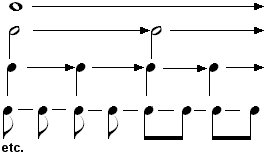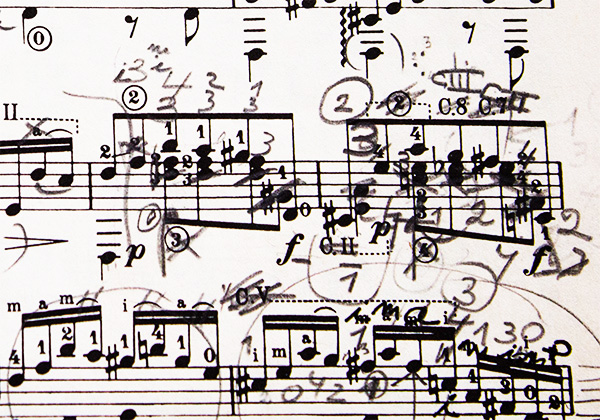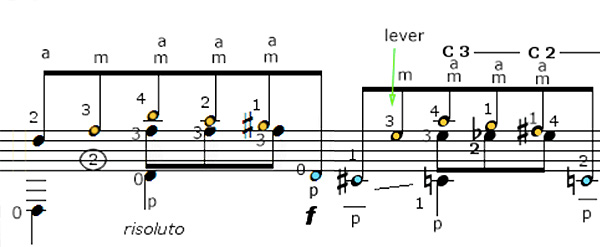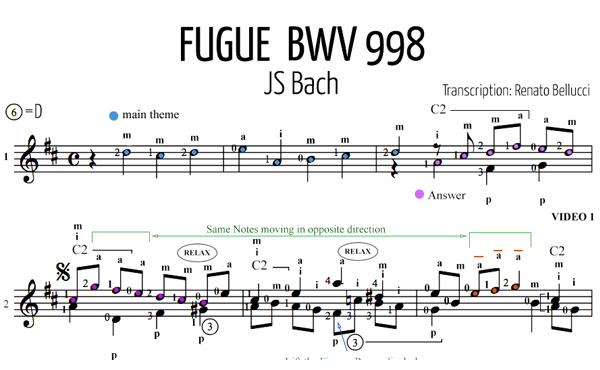Learn how to read music notation
Musicianship 1: Terminology
Beat: the pulse or throb that recurs regularly in music and that is accented periodically. The beat is the unit of measurement by which listeners judge the duration of a musical sound.
Tempo: the rate at which beats recur.
Meter: the way in which beats are grouped together and measured. Meter requires attention to the heaviness or lightness of the various beats. For example beat beat beat beat (suggests a grouping of twos); beat beat beat beat beat beat (suggests a grouping of threes). For practical purposes, think seconds when you think beats. Therefore: 1 beat = 1 second.
Note Values: symbols to indicate the passing of time in music. Various kinds of notes each represent a particular duration. The duration of a note is always figured in relation to the beat.

Whole note usually lasts for 4 beats (remember seconds).
Half note usually lasts for 2 beats.
Quarter note usually lasts for 1 beat.
Eighth note usually lasts for 1/2 beat.
Sixteenth note usually lasts for 1/4 beat.
The mathematical relationships among these note values is illustrated by the following chart. The arrows here represent the passing of time; they do not appear in actual music.

Consecutive notes may share flags for ease in writing and reading.

Rest: a sign to indicate silence for a certain period of time. For each kind of note there is a rest with the same name and time value.

The whole rest may also indicate an entire measure of rest, regardless of measure length. In such case it is called a measure rest.
Dotted Notes: a dot to the right of a note indicates that the note is lengthened by half of the original note value. In other words, the value of the dot depends on the value of the note preceding it. Assuming in each case below that a quarter note receives one beat, the duration of each dotted note is:


Time Signature or Meter Signature: the two numbers at the beginning of a piece of music. The meter signature indicates the meter or basic rhythmic grouping of the beats. This grouping is indicated by vertical bar lines in the music itself; the areas marked off by bar lines are called measures. The top number of the time signature tells how many beats are in each measure.
The bottom number tells what kind of note lasts for one beat. A 4 on the bottom stands for a quarter note, a 2 stands for a half note, and an 8 stands for an eighth note.
The time signature is not a fraction; 3/4 does not mean three-fourths, because it does not represent a portion of anything.
Two abbreviated time signatures are seen frequently:
(common time)

means

(cut time, or alla breve)

means

Meters are of two types. One has beats that are subdivided into twos; it is called simple time. The other, called compound time, subdivides the beat into threes.
The meter signature for compound time is more complex. Since the common note values are based on multiples of two, some type of dotted note must represent multiples of three. Furthermore, the meter signature must somehow indicate to the performer that the meter is compound. A signature such as 2 1/2 is impracticable. So the number of beat subdivisions is indicated in the top number, and the note value of each of these subdivisions is indicated in the bottom number. Hence usually means that there are two beats per measure, with a dotted quarter note receiving a beat:


Pitch
Note or tone: a symbol placed on the staff to indicate the pitch and duration of a particular musical sound.
Semitone*: what we find when we move between two notes (tones). We sometimes find a sharp. i.e..: Between C and D there are 2 semitones: C# and D. Between E and F there is one semitone: F. Semitones are also referred to as "half steps".
Staff: the five horizontal lines and four spaces upon which the notes are written.
Ledger Lines: short horizontal lines indicating the pitch of notes too higher too low to be placed on the regular staff. Ledger lines extend the range of the staff.

Clef: a sign placed on a staff to show the exact pitches of the notes written on the staff. The two most common clefs are: treble clef (or G clef, because it curls around the second line from the bottom, G); bass clef (or F clef, because it has two dots on either side of the fourth line, F).
The treble and bass clefs indicate definite pitches, all named for letters of the alphabet from A to G: Another clef sometimes encountered in instrumental music is the alto clef (or C clef, because it indicates the position of middle C). Unlike the piano for instance, the guitar only uses one Clef: The G clef. Sometimes to decongest the score, a single Staff or more are made into 2 separate staffs, but both are written in the Clef of G.

G clef

F clef

C clef
Sharp:

A sign placed before a note to raise the pitch one half step.
Flat:

A sign placed before a note to lower the pitch one half step.
Natural:

A sign placed before a note to indicate that it is neither raised nor lowered. This sign cancels a sharp or flat previously applied to the note.
UNDERSTAND & MEMORIZE MUSIC
If a musician relies exclusively on muscular or aural memory to memorize his repertory, he'd be relying on 2 definitely essential elements in the Music Understanding and Memorizing Process but he'd be missing out the larger more important and most reliable elements that ought to be present during the learning of a new piece. Namely: Visualization and Score Preparation.. This is especially true if you want to reduce the risk of your mind playing costly tricks on you at such crucial moments as during performance - public performance-. Public performance is the acid test for the musician because all your most unreliable emotions will be excited by the public exposure and, unless you have mastered these fundamental pillars of music understanding and memorization. Unless you start mastering these elements, you will most certainly never feel in control, -because you are not- and you will soon be questioning whether you got what it takes in order to be a world class performer or not. I do not know any professional musician who would venture on stage without having mastered these pillars to some degree. Guitarists, rank among the least prepared musicians in these terrains. The truth of the matter is that we never learn or even worst, are never thought how to master The Understanding and Memorization of music... I want to teach you how to do it, simply because I had to go through this process myself and my overall musicianship was never up to par until I "really" learned how to learn a piece of music.
Below you will see what the score of Bach Chaconne looked like after I decided to remove notes & change both right and left hand fingering. The score was literally filled with pencil markings to the point that I had to buy a second Segovia Transcription which was the staring point of my own transcription and fingering. Segovia's Work is simply monumental.

Below you can see what the score looks like today on mangore.com after having eliminated every marking that is not meant to be played and after creating my very own transcription. Every color, every marking is registered by the brain and this will translate in a much more clear image of the piece in the brain which in turn will translate in a better performance and way more security at the time of performing the piece especially for an audience.

Nevertheless, the 2 images above depict the final part of the strategic work. Below is what the "Playing Plan" -which you can see as a battle plan in the hands of a first class Field General- starts with. You can see the 2 opening staffs of Bach Fugue BWV 99. The Understanding of the music can be achieved with little and even very little music theory knowledge. This is because art music has a way of showing its beauty is very similar in the way that a picture can display its beauty even to the casual observer and the total beginner to art in general. Remember that beauty is one of the attributes of God and we are wired to seek it and recognize beauty in all its manifestations with great ease.
Just as you can express your feelings regarding a picture hanging on a wall, you can perceive and emit a verdict regarding a piece of music whether you can define the name of the notes there written. Written music is a graphic representation of the music being played and if the music sounds beautiful, the score will look beautiful. I want you to look attentively the 2 staffs below and define what you think you perceive about the piece by just looking at the "shape" of the music and then compare your findings to the list I enumerate below the staffs. I am sure that you will be surprised at discovering how much you were able to deciphered and see.

This is the process of visualization which will cement both the building of the necessary memory to play all the notes and which will allow your brain to process the playing much more efficiently because you will always have the blueprint of the work well impressed in your brain. Among the first things that become visible upon close observation, I spot the following:
1)The first 8 notes are a line of "self standing notes". This means that only one sound will be produced at any one time. A sequence of notes presented this way is referred to as melody. Being this melody the very first thing that appears in the piece and being the piece a Fugue, the name given to such melody is Main Theme. Every Fugue you will ever encounter begins presenting the Main theme. These are never longer than 1 or 2 staffs.
2)The following 8 notes that are presented are referred to as "The Answer" (Answer to the Main Theme, see it as a discourse) and if you look closely you will notice that the first note of the Answer starts with a note 4 steps lower than the first note of the Main Theme. The rule in the fugue is that the Answer must either start with the 5th note above the Main Theme first note or the 4th step below the first note of the Main Theme... Yes, Fugue is the most strict and difficult form in existence. This is why you have to be a musical genius if you were going to leave a mark using such strict rules. Many good composers tried but had not enough vision to make the music interesting. All Bach Fugues are not only beautiful, they are "Materia Prima" studied the world over by scholars and music lovers. Fugues are the most spiritual form of music because they will commit your whole being in order to get a true appreciation of their grandeur. It is only after hearing them a few times that you will begin to "hear" the musical "jewels" and you will like them more and more with every hearing and you will discover "things" throughout your life.
3)As soon as the Answer is through Bach starts knitting among each other the Main Theme and the Answer. Look at the first jewel consisting of 3 notes under 2 Green Brackets that walk in opposite direction....Continues
Asunción, April 26, 2016. S.D.G.
The continuation of this class is in the members area, become a member today.
 Back to Top
Back to Top



